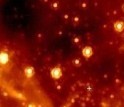News Release 05-215
Clarity at the Core
New techique provides first clear picture of the center of the Milky Way

A wide-angle view of the galaxy's center using the Keck Laser Guide Star system
December 23, 2005
This material is available primarily for archival purposes. Telephone numbers or other contact information may be out of date; please see current contact information at media contacts.
Using a new laser "virtual star" at the W.M. Keck observatory in Hawaii, astronomers have taken the first clear picture of the center of our Milky Way galaxy -- including the environs of a supermassive black hole at its very center.
"It's like getting Lasik surgery for the eyes," says team leader Andrea Ghez, professor of physics and astronomy at UCLA. "Everything is much clearer now."
The 10-meter Keck II Telescope is the first instrument of its size to incorporate Laser Guide Star adaptive optics, in which a laser-generated reference point high in the Earth's atmosphere -- a kind of artificial star -- is used to correct the atmosphere's distortions and clear up the the telescope's images.
Ghez and her colleagues, working with support from the National Science Foundation, have now used this technology to take snapshots of the center of the galaxy, 26,000 light years away.
Their findings are published in the Dec. 20 edition of Astrophysical Journal Letters.
The twin Keck telescopes, located atop Mauna Kea in Hawaii, are operated by the California Association for Research in Astronomy (CARA) on behalf of the California Institute of Technology, the University of California and NASA.
For more information, see the UCLA news release.
-NSF-
-
The supermassive black hole located at the center of the Milky Way
Credit and Larger Version
Media Contacts
M. Mitchell Waldrop, NSF, (703) 292-7752, email: mwaldrop@nsf.gov
Stuart Wolpert, UCLA, (310) 206-0511, email: swolpert@support.ucla.edu
Related Websites
UCLA Galactic Center Group: http://www.astro.ucla.edu/~jlu/gc/
UCLA news release: http://newsroom.ucla.edu/page.asp?RelNum=6693
The U.S. National Science Foundation propels the nation forward by advancing fundamental research in all fields of science and engineering. NSF supports research and people by providing facilities, instruments and funding to support their ingenuity and sustain the U.S. as a global leader in research and innovation. With a fiscal year 2023 budget of $9.5 billion, NSF funds reach all 50 states through grants to nearly 2,000 colleges, universities and institutions. Each year, NSF receives more than 40,000 competitive proposals and makes about 11,000 new awards. Those awards include support for cooperative research with industry, Arctic and Antarctic research and operations, and U.S. participation in international scientific efforts.
Connect with us online
NSF website: nsf.gov
NSF News: nsf.gov/news
For News Media: nsf.gov/news/newsroom
Statistics: nsf.gov/statistics/
Awards database: nsf.gov/awardsearch/
Follow us on social
Twitter: twitter.com/NSF
Facebook: facebook.com/US.NSF
Instagram: instagram.com/nsfgov



